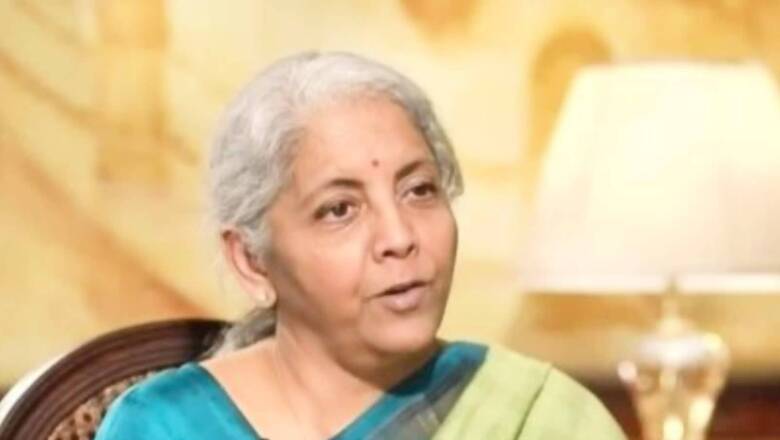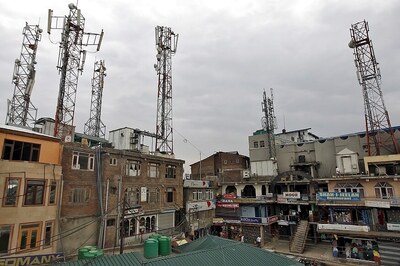
views
The economy is recovering but it still needs the government to spend on building assets that can lay the foundation for overall growth. Such capital expenditure (capex) will have a multiplier effect downstream on core industries and will finally nudge private sector capital expenditure. Once the private sector capital expenditure takes off, both the engines of the economy will be firing for sustained growth. Hence, Finance Minister Nirmala Sitharaman in her fourth Budget and in a concise speech focused on the attention where this capital expenditure should take place.
It is due to the government’s capital expenditure that the steel and cement industries are looking to expand capacities. The capital expenditure has increased from Rs 5.57 lakh crore to Rs 6.02 lakh crore in the revised estimates for 2021-22 and is now expected to go up to Rs 7.50 lakh crore in FY 2022-23. This includes Rs 1 lakh crore earmarked as special borrowing by states to be spent specifically on capital expenditure. This is an increase of more than 2.2 times the expenditure of 2019-20. This outlay in 2022-23 will be 2.9 per cent of the GDP.
This capital expenditure is happening because the GST revenues have not just stabilised above Rs 1.2 lakh crore but are showing a positive buoyancy. Capital expenditure is used for creating assets like infrastructure that have a long-term impact on the economic growth. MNREGA is also classified as capital expenditure as it is supposed to create some assets at the rural level. MGNREGA allocation had shot up to Rs 98,000 crore in the revised estimates for 2021-22 due to high demand, from the budget estimates of Rs 73,000 crore; in 2022-23, it has been kept flat at Rs 73,000 crore.
The FM also announced in her speech that the numbers for January 2022 were in excess of Rs 1.4 lakh crore. This is mostly due to better compliance and larger coverage of the GST system in the country. Once the private sector capex plans start firing, in the second half of 2022-23, the government revenue number may start looking better.
If the revenue increases more than what is expected, the fiscal deficit may be less than the projected 6.4 per cent. This conservatism in projection is good as positive surprises are welcome, not negative ones. The Finance Minister pointed out in the beginning of her speech the focus on four priorities: PM Gati Shakti; inclusive development, productivity enhancement and investment in sunrise opportunities; energy transitions and climate action; and financing of investments.
The quality and the focus of the capital expenditure on reducing the overall logistics cost of the economy by investing in multi-modal infrastructure under PM Gati Shakti is an important one. India’s logistics at 14 per cent of the GDP is the highest for a developing country and the government has set a goal of bringing it down to 10-11 per cent. Logistics cost reduces Indian manufacturers’ competitiveness both domestically and in export markets, it also erodes their margins making certain high volume items almost non-productive. China, on the other hand, directly subsidises global logistics costs for its exporters, making them competitive across the world.
Hence, Gati Shakti giving power and energy to speed of movement is very important for India. But this is not a short-term project; connecting riverways is a multi-year, multi-stakeholders project involving state governments. Hence, it needs a patient and engaging approach to make it happen. The beginning for which will be made with the Ken-Betwa project, for which an allocation of Rs 4300 crore was made in 2021-22 Budget and another Rs 1400 crore under this Budget.
The government wants to develop the PM Gati Shakti National Master Plan which will encompass the seven engines for economic transformation, seamless multimodal connectivity and logistics efficiency. It will also include the infrastructure developed by the state governments as per the Gati Shakti Master Plan. While there is no head for the allocation of expenditure for the development of the Gati Shakti Master Plan in the expenditure budget, the additional development of 25,000 kms of national highway in 2022-23 would be budgeted under the Ministry of Road Transport and Highways. Similarly, other ministries that will be involved in this mission will have allocation planned for them. Moreover, this is a mission and multi-year project so allocations will come in later years.
Meanwhile, the commitment for the Pradhan Mantri Grameen Sadak Yojana has gone up by 27 per cent. This also builds assets in rural areas although the labour component for these spends is being taken from MGNREGA allocation to synchronise the spend and efforts. The objective is that some real assets are built but it also adds to the complexity of these projects at the execution stage and thus increases the cost. From a process reforms perspective, this combination of labour costs from one scheme and material cost from another should be avoided. At the block and district level, it will be impossible for such projects to be executed.
The Finance Minister said something very important about repeated questions on no benefits for the tax paying public. She said, ‘Prime Minister ka yeh instructions tha fiscal deficit ka bojh kitna bhi ho jhel lena, magar janta par tax aur nahin badhana.’ She said this was the instruction from the PM last year too. And while people have the right to expect rebates, concessions and tax cuts from the Budget, it is not always possible as the objective of this and last year’s budget is to bring back the economy to a growth momentum. And, it is surprising that even in the pandemic year, almost every industry association has only been asking for tax sops. And even the media keeps asking about tax rebates to the middle class. Anchors on business channels also ask why the government doesn’t give better deductions on their income tax.
Nobody likes to see their hard earned money being taken away by the government in the form of taxes. But here one needs to remember John F. Kennedy’s famous words, “Ask not what your country can do for you, ask what you can do for your country.” And this year, it is not the time to ask for tax deductions as there are still people out there who do not have earnings, jobs or even enough to feed their families. Either we provide them succour or we believe that the government will be doing that with our tax money.
K. Yatish Rajawat is CEO, Center for Innovation in Public Policy. The views expressed in this article are those of the author and do not represent the stand of this publication.
Read all the Latest Opinions here



















Comments
0 comment